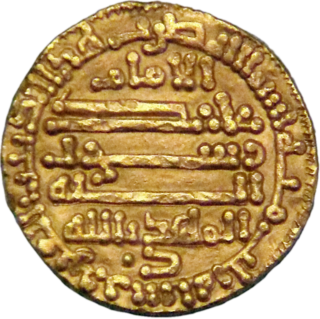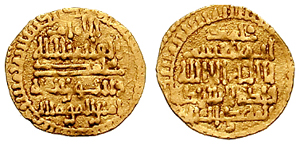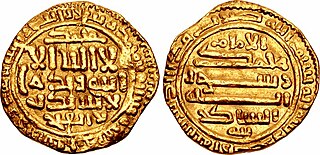Related Research Articles

Medieval Muslim Algeria was a period of Muslim dominance in Algeria during the Middle Ages, spanning the millennium from the 7th century to the 17th century. The new faith, in its various forms, would penetrate nearly all segments of society, bringing with it armies, learned men, and fervent mystics; in large part, it would replace tribal practices and loyalties with new social norms and political idioms.
The Kharijites, also called al-Shurat, were an Islamic sect which emerged during the First Fitna (656–661). The first Kharijites were supporters of Ali who rebelled against his acceptance of arbitration talks to settle the conflict with his challenger, Mu'awiya, at the Battle of Siffin in 657. They asserted that "judgment belongs to God alone", which became their motto, and that rebels such as Mu'awiya had to be fought and overcome according to Qur'anic injunctions. Ali defeated the Kharijites at the Battle of Nahrawan in 658, but their insurrection continued. Ali was assassinated in 661 by a Kharijite seeking revenge for the defeat at Nahrawan.

The Barghawatas were a Berber tribal confederation on the Atlantic coast of Morocco, belonging to the Masmuda confederacy. After allying with the Sufri Kharijite rebellion in Morocco against the Umayyad Caliphate, they established an independent state in the area of Tamesna on the Atlantic coast between Safi and Salé under the leadership of Tarif al-Matghari.

Abū Muḥammad ʿAbd Allāh ibn al-Ḥusayn, better known by his regnal name al-Mahdī biʾllāh, was the founder of the Isma'ili Fatimid Caliphate, the only major Shi'a caliphate in Islamic history, and the eleventh Imam of the Isma'ili branch of Shi'ism.
The Zenata are a group of Amazigh (Berber) tribes, historically one of the largest Berber confederations along with the Sanhaja and Masmuda. Their lifestyle was either nomadic or semi-nomadic.

Sijilmasa was a medieval Moroccan city and trade entrepôt at the northern edge of the Sahara in Morocco. The ruins of the town extend for five miles along the River Ziz in the Tafilalt oasis near the town of Rissani. The town's history was marked by several successive invasions by Berber dynasties. Up until the 14th century, as the northern terminus for the western trans-Sahara trade route, it was one of the most important trade centres in the Maghreb during the Middle Ages.
Ziri ibn Manad or Ziri son of Mennad was the founder of the Zirid dynasty in the Maghreb.
The Miknasa was a Zenata Berber tribe of the Maghreb.

Abū al-Qāsim Muḥammad ibn ʿAbd Allāh, better known by his regnal name al-Qāʾim (القائم) or al-Qāʾim bi-Amr Allāh, was the second caliph of the Fatimid dynasty, ruling in Ifriqiya from 934 to 946. He was the twelfth Isma'ili Imam, succeeding his father Abd Allah al-Mahdi Billah.

The Idrisid dynasty or Idrisids were an Arab Muslim dynasty from 788 to 974, ruling most of present-day Morocco and parts of present-day western Algeria. Named after the founder, Idris I, the Idrisids were an Alid dynasty descended from Muhammad through his grandson Hasan. Their reign played an important role in the early Islamization of Morocco and also presided over an increase in Arab immigration and Arabization in major urban centers.
Abu Abdallah al-Husayn ibn Ahmad ibn Muhammad ibn Zakariyya, better known as Abu Abdallah al-Shi'i, was an Isma'ili missionary (dāʿī) active in Yemen and North Africa. He was successful in converting and unifying a large part of the Kutama Berber tribe, leading them on the conquest of Ifriqiya from 902 to 909 and the overthrowing of the Aghlabid dynasty. This ultimately led to the establishment of the Fatimid Caliphate in Ifriqiya under the Imam–caliph Abdullah al-Mahdi Billah. However, Abdullah al-Mahdi Billah quickly fell out with Abu Abdallah and had Abu Abdallah executed on 28 February 911.
The Berber Revolt or the Kharijite Revolt of 740–743 AD took place during the reign of the Umayyad Caliph Hisham ibn Abd al-Malik and marked the first successful secession from the Arab caliphate. Fired up by Kharijite puritan preachers, the Berber revolt against their Umayyad Arab rulers began in Tangiers in 740, and was led initially by Maysara al-Matghari. The revolt soon spread through the rest of the Maghreb and across the straits to al-Andalus.
Ali ibn Umar was the seventh Idrisid ruler of Morocco.
Yahya IV or Yahya ibn Idris ibn Umar was an Idrisid ruler of Morocco, ruling in Fes from 905 to 922. For the last three years of his reign, he acknowledged the overlordship of the Fatimid Caliphate, until he was deposed by the Fatimid general Masala ibn Habus. He died in exile at the Fatimid capital of al-Mahdiya in 946.
Abū'l-Futūh Barjawān al-Ustādh was a eunuch palace official who became the prime minister (wāsiṭa) and de facto regent of the Shia Fatimid Caliphate in October 997, and held the position until his assassination. Of obscure origin, Barjawan became the tutor of heir-apparent al-Hakim bi-Amr Allah, who became caliph in 996 with the death of al-Aziz Billah. On al-Hakim's coronation, power was seized by the Kutama Berbers, who tried to monopolize government and clashed with their rivals, the Turkic slave-soldiers. Allied with disaffected Berber leaders, Barjawan was able to seize the reins of government for himself in 997. His tenure was marked by a successful balancing act between the Berbers and the Turks, as well as the rise of men of diverse backgrounds, promoted under his patronage. Militarily, Barjawan was successful in restoring order to the Fatimids' restive Levantine and Libyan provinces, and set the stage for an enduring truce with the Byzantine Empire. The concentration of power in his hands and his overbearing attitude alienated al-Hakim, however, who ordered him assassinated and thereafter assumed the governance of the caliphate himself.

The Midrarid dynasty was a Berber dynasty that ruled the Sijilmasa region in Morocco from their capital of Sijilmasa, starting in the late 8th or early 9th century to 976/7.
Mu'sab ibn al-Zubayr ibn al-Awwam was the governor of Basra in 686–691 for his brother, the Mecca-based counter-caliph Abd Allah ibn al-Zubayr, during the Second Fitna. Mus'ab was a son of Zubayr ibn al-Awwam, a prominent companion of the Islamic prophet Muhammad. Before becoming governor, he led an unsuccessful campaign against Umayyad-held Palestine. He defeated and killed the pro-Alid revolutionary Mukhtar al-Thaqafi after a series of battles in 687, gaining control over all of Iraq. Complaints from the Iraqis caused his removal from office by his brother, but he was restored shortly after. He was killed by Umayyad forces led by the caliph Abd al-Malik in the Battle of Maskin four years later.

Muhammad ibn al-Fath Wasul ibn Maymun al-Amir was the tenth Midrarid emir of Sijilmasa. He was the first Midrarid ruler to adopt Maliki Sunni Islam.
Abu'l-Maghra ibn Musa ibn Zurara was the last Zurarid emir of Arzen, located on the borders between Upper Mesopotamia and Armenia, which at the time were provinces of the Abbasid Caliphate.
Isa ibn Mazyad al-Aswad was the first ruler of the oasis town of Sijilmasa, in what is now southeastern Morocco.